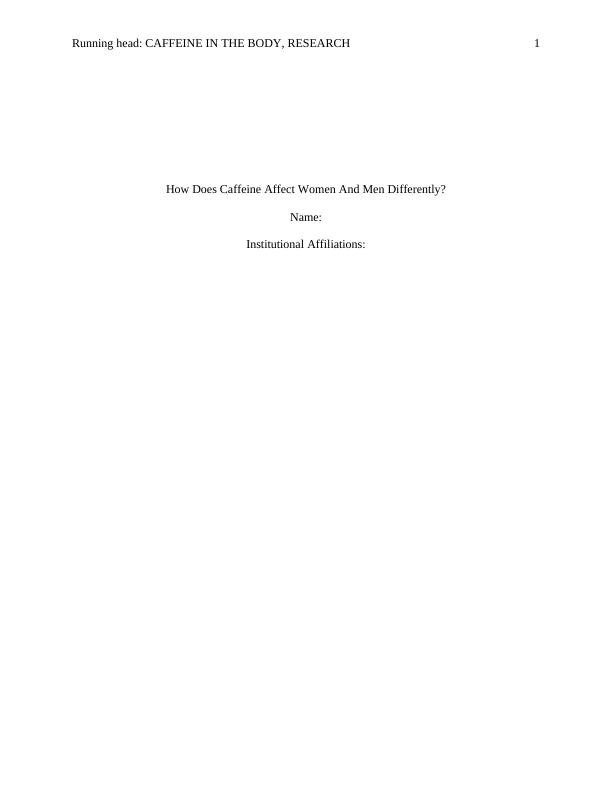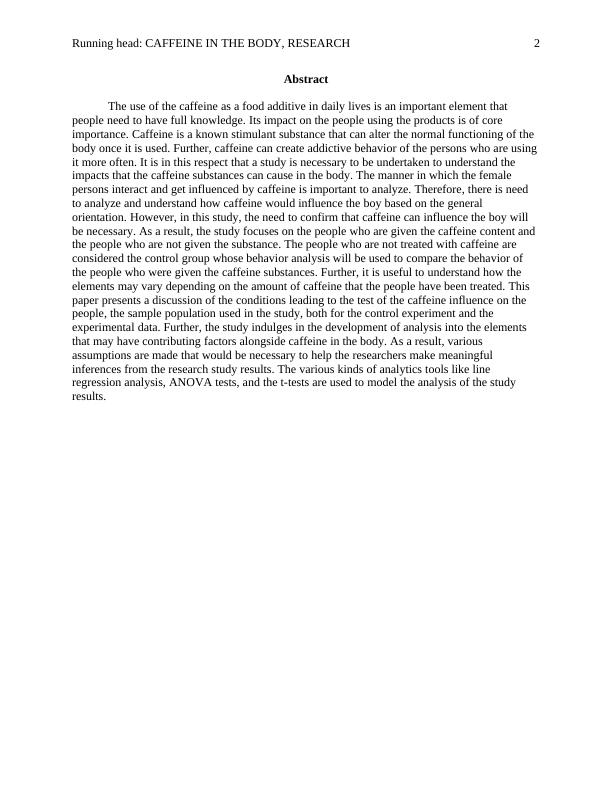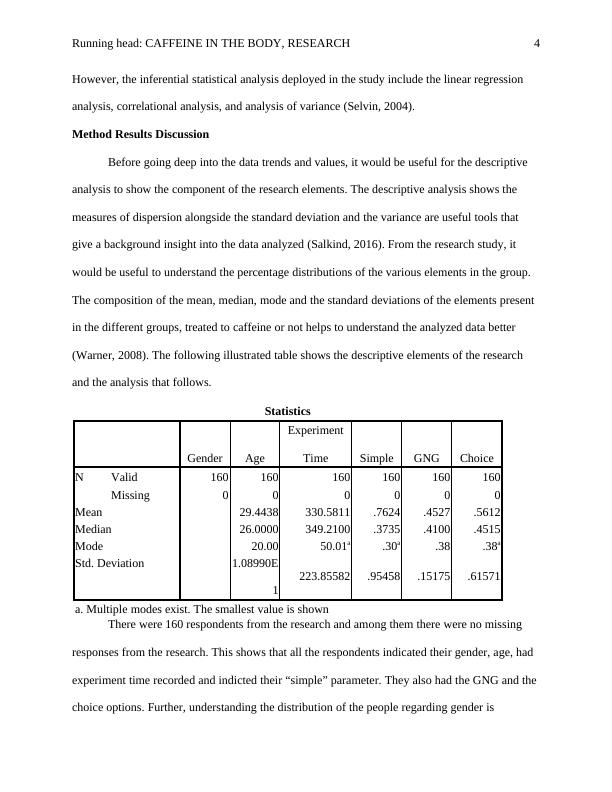Caffeine in the Body: Research
Added on 2020-03-28
16 Pages3508 Words359 Views
Running head: CAFFEINE IN THE BODY, RESEARCH1How Does Caffeine Affect Women And Men Differently?Name:Institutional Affiliations:

Running head: CAFFEINE IN THE BODY, RESEARCH2AbstractThe use of the caffeine as a food additive in daily lives is an important element that people need to have full knowledge. Its impact on the people using the products is of core importance. Caffeine is a known stimulant substance that can alter the normal functioning of the body once it is used. Further, caffeine can create addictive behavior of the persons who are usingit more often. It is in this respect that a study is necessary to be undertaken to understand the impacts that the caffeine substances can cause in the body. The manner in which the female persons interact and get influenced by caffeine is important to analyze. Therefore, there is need to analyze and understand how caffeine would influence the boy based on the general orientation. However, in this study, the need to confirm that caffeine can influence the boy will be necessary. As a result, the study focuses on the people who are given the caffeine content and the people who are not given the substance. The people who are not treated with caffeine are considered the control group whose behavior analysis will be used to compare the behavior of the people who were given the caffeine substances. Further, it is useful to understand how the elements may vary depending on the amount of caffeine that the people have been treated. This paper presents a discussion of the conditions leading to the test of the caffeine influence on the people, the sample population used in the study, both for the control experiment and the experimental data. Further, the study indulges in the development of analysis into the elements that may have contributing factors alongside caffeine in the body. As a result, various assumptions are made that would be necessary to help the researchers make meaningful inferences from the research study results. The various kinds of analytics tools like line regression analysis, ANOVA tests, and the t-tests are used to model the analysis of the study results.

Running head: CAFFEINE IN THE BODY, RESEARCH3Introduction and Literature Review Is there a possibility that caffeine affects women and Men Differently? This is the research question that the analysis in this documents needs to model and present in a way that will lead to the development of understanding of the research models and concepts. This study deploys the experimental data that presents how different people reacted to the use of caffeine. The analysis is undertaken using SPSS. The kinds of tests and analysis were undertaken in the process include descriptive tests, linear regression analysis, ANOVA analysis and correlation analysis. The analytical values are presented in tables and graphs for easy reading and interpretations. This paper, therefore, aims to validate or nullify the null hypothesis, “Caffeine does not affect people of different ages in different ways.”The amount of caffeine that people use may have different kinds of impacts on their lives (Satel, 2006). Nehlig and Boyet believe that some caffeine may have a different level of impacts on the lives of the consumers, based on the quantity that they consume and the gender of the persons consuming caffeine (Nehlig & Boyet, 2000 p. 75-7). Notably, caffeine consumption and its impacts on the body can be modeled and studied using the statistical tools of analysis (Lean and Crozier, 2012). Through the development of corresponding knowledge in the field of the study, different kinds of analysis can be undertaken to help in examining the extent of the caffeine use in the body. Some analytical tools are descriptive, and others are inferential. The descriptive analysis is considered superficial, showing the basic characteristics of the data analyzed in the study (Eriksson et al., 2013). Nonetheless, the descriptive statistical analysis methods provide the foundation for the study. Therefore, the study deploys both the inferential and the descriptive statistical data analysis. The descriptive data analysis method include the analysis of the mean, mode, variances and the measures of the standard deviations in some cases.

Running head: CAFFEINE IN THE BODY, RESEARCH4However, the inferential statistical analysis deployed in the study include the linear regression analysis, correlational analysis, and analysis of variance (Selvin, 2004). Method Results Discussion Before going deep into the data trends and values, it would be useful for the descriptive analysis to show the component of the research elements. The descriptive analysis shows the measures of dispersion alongside the standard deviation and the variance are useful tools that give a background insight into the data analyzed (Salkind, 2016). From the research study, it would be useful to understand the percentage distributions of the various elements in the group. The composition of the mean, median, mode and the standard deviations of the elements present in the different groups, treated to caffeine or not helps to understand the analyzed data better (Warner, 2008). The following illustrated table shows the descriptive elements of the research and the analysis that follows. StatisticsGenderAgeExperimentTimeSimpleGNGChoiceNValid160160160160160160Missing000000Mean29.4438330.5811.7624.4527.5612Median26.0000349.2100.3735.4100.4515Mode20.0050.01a.30a.38.38aStd. Deviation1.08990E1223.85582.95458.15175.61571a. Multiple modes exist. The smallest value is shownThere were 160 respondents from the research and among them there were no missing responses from the research. This shows that all the respondents indicated their gender, age, had experiment time recorded and indicted their “simple” parameter. They also had the GNG and the choice options. Further, understanding the distribution of the people regarding gender is

End of preview
Want to access all the pages? Upload your documents or become a member.
Related Documents
Does Caffeine Affect Females Differently Paperlg...
|1
|1722
|49
Biostatistics in Healthcare and Medical Researchlg...
|7
|1149
|123
Analysis of Retail Surge's Product Categories: Profit, COGS, Payment Methods, and Customer Attitudes | Deskliblg...
|26
|4312
|494
Effect on Color in Psychology, Physiology and Behavior of Humanlg...
|22
|5102
|236
Lipophilicity Test on Ibuprofen & Lidocaine Institution Affiliationlg...
|20
|3191
|14
Variables in the Evidence-Based Practiceslg...
|9
|2514
|28
